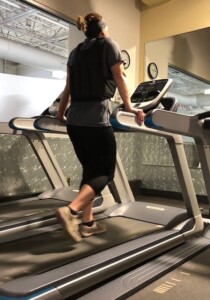
When I was a personal trainer I made sure that all my clients learned to walk properly on a treadmill.
It’s amazing how many people have this all wrong. But the problem is actually easy to fix.
Though fear of falling off is a leading reason for why people hold onto a treadmill, there’s something about that shoulder bob that tells me that fear of falling off isn’t relevant to why they do this.
The shoulder bob seems to be more habit than safeguarding—a habit that in many walkers gets carried away over time—their shoulders bob up and down, like buoys in choppy water.
What kind of walking is this, anyways? It’s not how people walk when they’re not on a treadmill. I’ve never seen the shoulder bob off a treadmill.
The locking up of the arms totally throws off the gait, transforming it into something very artificial.
It’s unreal walking. Fake movement—fake in that it has no carryover once the walker steps off the machine.
People who do this are fooling only themselves. They may never find this out, though, as long as they don’t have to ever do brisk and/or prolonged real walking for extended periods off the machine.
At a gym I used to train at, I’d always see this one particular man—he was in his 50s or 60s—and his shoulder bobbing was so pronounced that it hurt just to watch him.
His posture was crazy (which included a hyperextended back) and his feet barely made contact with the tread because his locked-out arms were supporting so much of his weight.
The Shoulder Bob Can Injure the Shoulders

Shutterstock/lunopark
“This pushes the humerus up into the acromion and can lead to rotator cuff impingement and pain,” says says Joseph Ciotola, MD, orthopedic surgeon at The Orthopedic Specialty Hospital at Mercy Medical Center.
In other words, the upper arm bone gets pushed into a small space in the shoulder joint–there’s not enough room for this to happen–and the tip of the bone ends up pressing against a nearby tendon, irritating it.
Over time, this contact can cause “fraying” of the tendon: painful impingement.
Of all the ways to hold onto a treadmill, the shoulder bob subtracts the most body weight.
The side positioning of the arms and hands puts the walker in a position to literally lift their weight off the tread and “lip synch” their walking.
Yes, the shoulder bob is the lip-synching of treadmill walking. It’s feet-synching.
If shoulder bobbers have difficulty walking without so much support, then they should slow down. Often, this type of walker has the speed set at around 4 mph, sometimes 4.5, and walk-synchs this.
Reduce the speed to 3 mph and take your hands off. If this is difficult, I hope by now you know why.
Walk-synching is so far-removed from real walking, that it does nothing to improve your ability to walk without subtracting your weight. It does nothing to improve aerobic capacity.
Reduce the speed enough so that you can actually do real walking (arms moving naturally at your sides) without becoming overwhelmed with fatigue.

 Dr. Ciotola
Dr. Ciotola






































